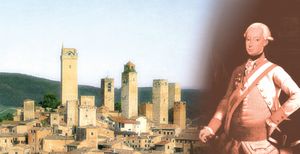There is a light rain and a nip in the breeze as I step out onto the slippery cobble stone alley that has become, in a sense, my street. I’m on my way to the Antico Setificio Fiorentino, an ancient silkmaking factory and a point of pride for Florence. It is tucked away in a quiet garden setting, at the end of an unexpected driveway lined with plants and ivy. At the gate, I ring the bell, summoning a woman who lets me in with a smile. She leads me to the showroom: the only part open to the public. As I pass I can hear the sounds of the shifting looms inside the factory.
The Setificio dates back to the 17th century, having survived two world wars and the flood of 1966. It was created when six of the wealthiest families of the silk-making industry combined efforts, materials and creativity under one roof. Looms donated by Pietro Leopoldo and a hand dyer designed by Leonardo da Vinci are still in use today by ten master weavers. The fabrics created are made with only the softest silk from Brazil into original antique patterns and those designed by special clients.
Rounding the corner, I cross the entrance to the first area of the showroom. I am taken aback at first by the numerous colors and patterns filling my view, then, almost simultaneously, by the exotic scent of what seems to be scores of various flowers and spices. There in the room is a young and petite Italian woman, complete with measuring tape around her neck.
When I inquire about the scent, she shows me to a basket containing small silk bags with tags, explaining that they are reproductions of the potpourri given to Catherine de’ Medici before she left Florence to become Queen of France. The well known Medici family is only one of those to benefit from the products of the silk factory. The client list includes important families, nobility and religious affiliates of Tuscany, America and Europe, some of whom were captured in now classic paintings of the era. The fabric today is mostly used to restore interiors and their furnishings, and is even featured in places such as the Grand Palais at the Kremlin and the St. Andrew Throne Hall.
Starting a conversation with her, I come to find she is the only hand embroider of the Setificio. I begin asking her questions, in my terribly broken Italian, which quickly leads us to use her only slightly less broken English. She tells me that she has been an embroider all of her life, having studied under the last master there in the Setificio. She informs me that she has completed many prestigious projects, including two dresses for women of the Pucci family who are now the only remaining owners of the original six. I ask ‘How do you feel about such accomplishments?’ She point to pictures of magnificent halls and palaces and says with humble pride, ‘Of embroidery, this is the best.’ It’s hard to argue with her, seeing the surrounding couches, chairs, purses, boxes, books, ties, pillows and decorations that back up her statement.
I direct her over to unwound amounts of silk hanging on pegs in another room. I say they are the softest thing I have ever felt, and her eyes twinkle. Her small, delicate hands take one of the silk groupings and balls it up. ‘It’s the sound of the silk,’ she says. ‘Listen,’ and she squeezes and twists the mound of gold to release small whiney shouts from the threads. ‘If it no makes a sound, it’s no good. Need the sound.’
While there, one of the weavers comes in and he gladly offers to answer any question I have. From our conversation I learn that out of ten weavers he is the only male weaver, and that it has basically always been this way. The only way to learn to weave for the Setificio is to come and learn from a master already there. It takes different amounts of time to learn all the different fabrics. Weavers come from all around the world and almost never see their finished product. They have no negative side effects from working the looms eight hours a day; ear plugs and taped hands are sufficient safety devices.
Soon it is time for me to go, and I am being shown out by the embroider, whose name I never did catch. She stops at the open doorway to the factory that I passed on the way in. Briefly I wave hello to one of the women mastering the mechanical looms, catch a look at the dyer designed by Leonardo, and observe a sign marking the height of the Arno during the flood of 1966. We turn to leave and I can’t wipe the smile off of my face. As I am led toward the gate I offer, ‘Grazie, molte grazie,’ and shyly ask ‘come si dice beautiful?’ She turns to me with a smile and as she opens the gate says, ‘Yes, the Setificio is a very special place.’





